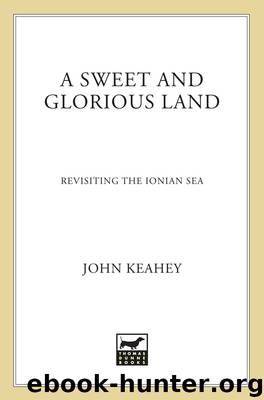A Sweet and Glorious Land by John Keahey

Author:John Keahey
Language: eng
Format: epub
ISBN: 9781466876033
Publisher: St. Martin's Press
Southern Basilicata/southern Puglia
Chapter 11
Sunlight on Old Stones
I arrived about midday. Taranto is a strange and wonderful city high on the inside of Italy’s heel. From the train station, I took a quick bus ride across a bridge to the island containing the old medieval city that was built on the ruins of Roman Tarentum and Greek Taras. The bus carried me farther east toward a hotel on a side street in the modern downtown, the Albergo Piasi. This new city, città nuova, developed across from the southeast end of the island, was connected by a drawbridge.
The old city, the città vecchia, is made up of structures dating back to the medieval period. Very little exists from the Roman era, and, near the drawbridge, a single stone column juts into the sky—the only visible evidence that Greeks first settled this spot, and in the light of the setting sun, that column becomes a golden tribute to that era.
In Greek times, the ancient city of Taras, founded in about 706 B.C.E. by colonists from the Greek city of Sparta, ended at a defensive wall near the neck of the peninsula with a ditch located near the point where the canal and drawbridge now sit. Later, after 275 B.C.E., the Romans took over the city, naming it Tarentum.
Before the ditch was widened into a canal in the Middle Ages, making the city an island, the old city had once been part of the peninsula to the south, between the Mare Piccolo, (the Little Sea) and the Gulf of Taranto. It was across this peninsula that Hannibal’s soldiers, in 212 B.C.E., used mules to haul ships lashed to wagons from the Little Sea to the Gulf of Taranto and surprise the city’s Roman defenders. After Hannibal, the Romans once again re-established their control over the city.
The writer Margaret Guido credits the ancient geographer Strabo with a fine description of the city around the time of the first millennium:
“Evidently the town had a fine gymnasium and a spacious forum still dominated by the huge bronze figure of Zeus. But the acropolis (the upper fortified part of an ancient Greek city), between the forum and the harbor mouth, had already been shorn of most of its former glories. The via Appia approached the town by a bridge across the harbor mouth and, having crossed the present Città Vecchia and Città Nuova, left by a gateway through the walls on the east, just beyond the [cemetery].”
Strabo, a Roman citizen who wrote in Greek and likely was Greek by birth, described the whole of the known world during the reigns of the first two Roman emperors, Augustus and Tiberius. He apparently saw Tarentum long after the Romans had despoiled much of the older Taras to rebuild their own city. Ever the dispassionate observer, I wonder how Strabo must have felt about his older Greek culture’s former glories being stripped away at Tarentum.
Taranto became an island some fifteen hundred years later, in C.E. 480, under Aragonese rulers, far away from their native Spain.
Download
This site does not store any files on its server. We only index and link to content provided by other sites. Please contact the content providers to delete copyright contents if any and email us, we'll remove relevant links or contents immediately.
Spell It Out by David Crystal(35365)
Underground: A Human History of the Worlds Beneath Our Feet by Will Hunt(11279)
A Year in the Merde by Stephen Clarke(4670)
Venice by Jan Morris(2058)
Claridge's: The Cookbook by Nail Martyn & Erickson Meredith(1974)
My Paris Kitchen: Recipes and Stories by Lebovitz David(1897)
A TIME OF GIFTS by Patrick Leigh Fermor(1853)
The Plantagenets by Dan Jones(1623)
Welcome to the Goddamn Ice Cube by Blair Braverman(1609)
Bang Poland: How To Make Love With Polish Girls In Poland by Roosh V(1595)
Top 10 Prague (EYEWITNESS TOP 10 TRAVEL GUIDES) by DK(1572)
From Russia with Lunch by David Smiedt(1555)
The Finnish Way by Katja Pantzar(1540)
The Isle of Mull by Terry Marsh(1524)
A TIME TO KEEP SILENCE by Patrick Leigh Fermor(1504)
Rick Steves London 2018 by Rick Steves & Gene Openshaw(1498)
A Taste of Paris by David Downie(1496)
Merde in Europe by Stephen Clarke(1439)
Insight Guides Experience Tokyo by Insight Guides(1422)
